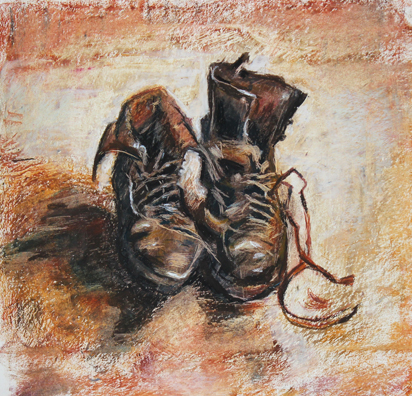Boots
(After Van Gogh)

If you do a "master copy" of a painting by a famous artist but the rendering is not quite what you could call a copy, then you say the art is "after" whatever artist you are trying to copy.
This painting, then, is "after" Vincent Van Gogh. Vincent painted the picture probably in the second half of 1886 when Vincent was living in Paris. The original is in the Van Gogh Museum in Amsterdam. You can, if you wish, read a bit more about Vincent (in a new window) if you click here.
This copy - sorry, that's "rendering" - is in a fairly unusual medium called oil pastels. And calling it a painting is not inaccurate as that's what most pastelists do, eschewing the word (ptui) "drawing.
Oil pastels are in fact a fairly young medium in the world of art, being only about a century old. In the strictest sense oil pastel sticks are crayons in that they are pigments bound in wax.
Now oils and waxes from vegetable oils - used in oil paints - dry out. But they don't dry in the sense that a solvent evaporates. Instead, the oil molecues - a wax is an oil with a melting point above room temperature - react with oxygen and start linking with other oil molecules. Eventually you get molecules so large - that is, polymers - that they don't flow or even melt.
But there are some waxes that don't react with oxygen and so don't link together. Some are made from vegetable oils in a way that reduces their reactivity. Or the wax can be petroleum based. Such waxes are nonreactive to air. It's such non-reactive waxes that are used in oil pastels. By choosing the right blends of oils and waxes you can make an oil pastel stick of any desired degree of hardness or softness
Since the sticks are made with wax that doesn't dry out, that means oil pastel drawings - sorry, that's the "paintings" - don't dry out either. Nor is there any fixative that will completely prevent the drawing from smudging. So the pictures have to be framed carefully so the surface doesn't touch the glass. If you store them, the surface can't touch anything.
The big advantage over traditional pastels is that unlike dry pastels, oil pastels they don't produce dust. Not only is dust with pigments bad to inhale, it can also can mess up your studio. Oil pastels, though, can still make a mess, particularly if they are of the softer varieties. Sad to say there is no real art form - other than digital art - that doesn't have the potential to trash your house.